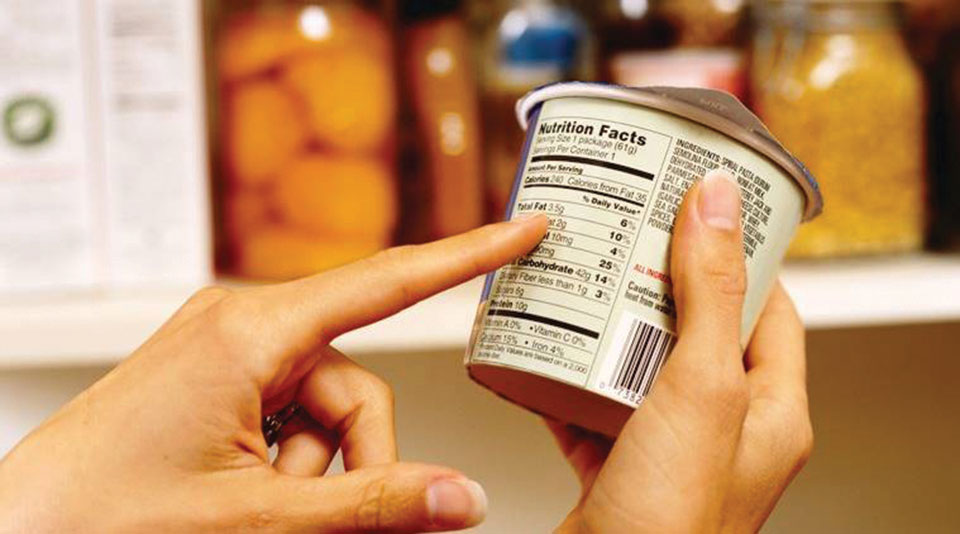
OR

More from Author
Food manufacturing companies freely label their food as healthy, fresh, pure, original and natural even if it may not be so
Nutrition plays an important role in everyday life of people. Nutritional label is a systematic way of presenting nutrition information of food product. The description is used to inform the customer about the nutritional properties of a food, which also helps the customer in purchasing nutritious food and consuming nutritionally balanced meals. It is presented in a tabular format with headings such as “nutrition information”, “nutrition fact’, or “nutrition label”. The nutritional label is required as a guide for the consumer to make selection from a list of food products and to encourage consumption of healthy products.
Nutritional label can simplify the whole concept of healthy diet because it helps the customer to keep track on the intake of nutrients such as the amount of fat, sugar, sodium, fiber, protein and carbohydrates. It also assists consumers to make an informed judgment of a product’s overall value. Healthy nutrition plays a critical role in maintaining the wellbeing of society and health in general.
Nutrition information panels are required to provide information on certain nutrient components: Calories from fat, calories from saturated fat, total fat, saturated fat, polyunsaturated fat, monounsaturated fat, cholesterol, sodium, potassium, total carbohydrates, dietary fiber, soluble fibre, insoluble fibre, sugar, alcohol, protein, vitamins, iron and other minerals. If a claim is made about any of the optional components, or if a food is fortified or enriched with any of them, nutrition information for these components becomes mandatory.
Misleading the consumers
However, with overload of nutrition labels, food choices and advertisements available, at times, it has become very difficult for the average consumer to sort through healthy and unhealthy choices. For example, there has been a startling trend of misleading labels on the packaging of food. Since nutritional and advertising labels play a very critical role in consumer’s behavior, it is imperative that we educate consumers on the true meaning behind food labels.
Many companies freely label their food with healthy labels, even if they do not fit the criteria. Consumers are blindly falling for misleading labels without considering the nutritional facts.
Food packaging companies are required to provide nutritional food labels on packet foods. But many people have a hard time deciphering true meaning of food labels. Both too much and too little information can confuse consumers and mislead them. We must put an end to the negative influence that misleading food labels have on society.
Food labels include any tag, brand, mark, pictorial or other descriptive matter, written, printed, marked, painted, embossed or impressed on, or attached to or included in, belonging to, or accompanying any food. The key information (such as calories, saturated fats, sodium and sugars) allows consumers to decide whether the product is healthy or not.
Incongruously, food manufacturing companies freely choose to label their food as healthy, fresh, pure, original, even if it may not fit the criteria. Research studies have found that there is “an increase in the sales of items marked identifying low sodium, cholesterol, fat, and calories.” On the front of the chips bags they post the “natural” labelling, without really looking at the nutritional details. This label fools customers and they forget to look on the back for the actual nutritional details. Food with natural labeling should be using “ingredients extracted directly from plants or animal products as opposed to being produced synthetically.”
Discretionary nutrition labelling is becoming conventional for food companies and retailers, but the practice poses some issues. Discretionary nutrition labels are placed on front-of package with claims such as “No Trans Fat” or “Made with 100% Whole Wheat,” or more general, such as “Natural” or “Good Source of Fiber.” There are several potential risks in making such claims.
Misleading labels such as “no trans fat” can affect the customer’s choice to purchase the product without reading the details. Trans fat is found in many foods such as margarines, crackers, cookies, and snack foods, including microwave “buttered” popcorn and items made with or fried in partially hydrogenated oil, including some French fries, potato chips, salad dressings and cakes. The biggest sources of trans fat are commercial products such as cakes, cookies, crackers, pies, and breads, followed by animal products and margarine. One problem associated with trans fats is Coronary heart disease (CHD). Research has shown that high cholesterol can be the result of eating a diet with too much saturated fat and cholesterol.
Besides many products with food labeling claiming healthy immune system show false pictures on their packaging but have no proof of containing the product. One such example is the label for juice treats, a product intended for preschoolers. Pictures show abundance of fruits: oranges, grapes, peaches, cherries, pineapple and raspberries. But there is no cherry, orange, or pineapple in the product, and less than two percent is raspberry and apple juice concentrate. The main ingredients are corn syrup and sugar.
Likewise, in labels of cooking oil of plant origin, ‘cholesterol free/ no cholesterol’ is highlighted which forces the consumer to purchase. In most biscuits and cookies labels such as ‘no sugar’ and ‘sugar free’ are pasted. The consumers do not properly understand this. Instead of putting ‘sugar free’ or ‘no sugar’ claims ‘no added sugar’ label must be used.
What can be done?
Transparency for consumers through nutrition labeling should be the first step in a transformative food policy to reduce dramatic health disparities and raise health standards of people. Transparency in the food system is a key focal point of efforts to improve health by providing consumers with necessary information to make good nutritional choices, as well as to achieve sustainable food chains and ensure food safety and quality.
Eating a well-balanced nutritional diet is important for maintaining health. To help support this cause, food producers should follow Codex labelling requirements and avoid false labelling. The Codex Alimentarius Commission (a collection of internationally recognized standards, codes of practice, guidelines, and other recommendations relating to foods, food production and food safety) has encouraged consistency between trading partners, but different countries have developed a diverse array of approaches to these requirements.
Although many companies start off by having good intentions, the judgment to put labels on food should be coordinated by nutritional experts, not companies because the companies might put labels on their products to increase sales, without really considering the nutritional facts. Healthy eating is crucial for the general public and more efforts should be made to help them make better choices.
First, people should be educated on proper nutrition so they know what choices to make. Second, the producers should make an effort to provide simpler labels for people to understand. Such labels must not be misleading. There needs to be a greater enforcement on putting labels on products. Food label should provide information that includes the name of food, list of ingredients, nutritional information, declaration regarding vegetarian or non-vegetarian, declaration regarding food additives, name and complete address of the manufacturer or packer, net quantity, code number, lot number, date of manufacture or packing, best before and use by date, country of origin for imported food, and instructions for use. This should be mentioned in both international and native languages.
The way nutrition labels are formatted influences how effectively they can be used and interpreted by the consumers. There are a number of directions food policy can take to reduce health disparities and improve health outcomes. Policy makers should operate independently of industry influence. Public health should be their top priority.
The mandate to guide reforms should include: desubsidization of commodities that fuel the markets for non-nutritious foods such as fast food, sweetened beverages and processed foods, ban on extremely harmful food additives, imposing limits on food ingredients linked to less serious but problematic health conditions, establishment of higher standards for school lunches and other government assistance programs, elimination of distribution of unhealthy food to children and women among others. Most of all, consumers need honest labelling which they can depend on for making healthy choices in order to avoid diet-related disease.
The author is a food technologist
You May Like This

43% Nepali children below five years are malnourished: UNICEF
KATHMANDU, Oct 16: Around 43 percent children under the age of five are malnourished in Nepal, according to a report... Read More...

Serving better taste and sweetness
We enjoy eating the food we love. Despite being knowledgeable about good nutrition and ways to eat healthy, people are... Read More...

Biplav Maoists halt food supplies, Humla, Mugu under food shortage
HUMLA, Jan 21: For the past 10 days, the Biplav led Maoist faction have seized daily food supplies and 300... Read More...







Just In
- NRB to provide collateral-free loans to foreign employment seekers
- NEB to publish Grade 12 results next week
- Body handover begins; Relatives remain dissatisfied with insurance, compensation amount
- NC defers its plan to join Koshi govt
- NRB to review microfinance loan interest rate
- 134 dead in floods and landslides since onset of monsoon this year
- Mahakali Irrigation Project sees only 22 percent physical progress in 18 years
- Singapore now holds world's most powerful passport; Nepal stays at 98th












Leave A Comment